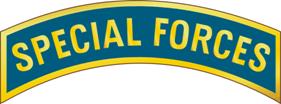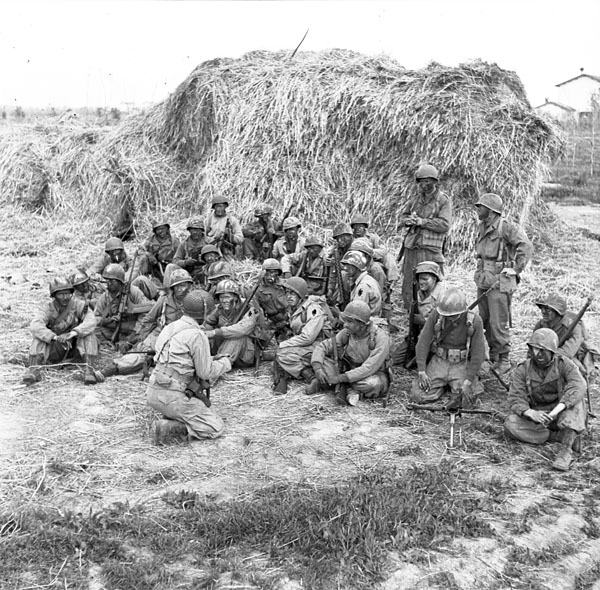|
Special Forces Tab
The Special Forces Tab is a service school qualification tab of the United States Army, awarded to any soldier completing the Special Forces Qualification Course at the U.S. Army John F. Kennedy Special Warfare Center and School, Fort Bragg, North Carolina. Soldiers who are awarded the Special Forces Tab are authorized to wear it and the green beret for the remainder of their military careers, even when not serving in a Special Forces command. Because it is longer than the other qualification tabs, it is called the "Long Tab". Personnel who have earned it are nicknamed "Long Tabbers." Description and history The Special Forces Tab was created in 1983 and is an embroidered quadrant patch worn on the upper left sleeve of a military uniform. The cloth tab is 3 inches wide, 3/4-inch high, and is teal blue with gold-yellow embroidered letters. A metal Special Forces Badge is authorized for wear on mess dress and class-B uniforms. The metal badge is teal blue with a gold edge and ... [...More Info...] [...Related Items...] OR: [Wikipedia] [Google] [Baidu] |
1st Special Service Force
The 1st Special Service Force was an elite American–Canadian commando unit in World War II, under the command of the United States Fifth Army. The unit was organized in 1942 and trained at Fort William Henry Harrison near Helena, Montana in the United States. The Force served in the Aleutian Islands, and fought in Italy, and southern France before being disbanded in December 1944. The modern American and Canadian special operations forces trace their heritage to this unit. In 2013, the United States Congress passed a bill to award the 1st Special Service Force the Congressional Gold Medal. History Background Geoffrey Pyke was an English journalist, educationalist, and later an inventor whose clever, but unorthodox, ideas could be difficult to implement. In lifestyle and appearance, he fit the common stereotype of a scientist-engineer-inventor or in British slang, a "boffin". This was part of the British approach in World War II, of encouraging innovative warfare methods ... [...More Info...] [...Related Items...] OR: [Wikipedia] [Google] [Baidu] |
Maroon Beret
The maroon beret in a military configuration has been an international symbol of airborne forces since the Second World War. It was first officially introduced by the British Army in 1942, at the direction of Major-General Frederick "Boy" Browning, commander of the British 1st Airborne Division. It was first worn by the Parachute Regiment in action in North Africa during November 1942. Origins The first British army unit to adopt the beret was the Armoured Corps in 1924 (for more information see black beret). During World War II some British Army units followed the lead of the Armoured Corps and adopted the beret as a practical headgear, for soldiers who needed a hat that could be worn in confined areas, slept in and could be stowed in a small space when they wore steel helmets. A popular story is that the maroon colour was chosen by Major-General Frederick Browning, after his wife, Daphne du Maurier, suggested that he use the colour which made up part of his horse raci ... [...More Info...] [...Related Items...] OR: [Wikipedia] [Google] [Baidu] |
Bloomsbury Publishing
Bloomsbury Publishing plc is a British worldwide publishing house of fiction and non-fiction. It is a constituent of the FTSE SmallCap Index. Bloomsbury's head office is located in Bloomsbury, an area of the London Borough of Camden. It has a US publishing office located in New York City, an India publishing office in New Delhi, an Australia sales office in Sydney CBD and other publishing offices in the UK including in Oxford. The company's growth over the past two decades is primarily attributable to the ''Harry Potter'' series by J. K. Rowling and, from 2008, to the development of its academic and professional publishing division. The Bloomsbury Academic & Professional division won the Bookseller Industry Award for Academic, Educational & Professional Publisher of the Year in both 2013 and 2014. Divisions Bloomsbury Publishing group has two separate publishing divisions—the Consumer division and the Non-Consumer division—supported by group functions, namely Sales and Mar ... [...More Info...] [...Related Items...] OR: [Wikipedia] [Google] [Baidu] |
Distinctive Unit Insignia
A distinctive unit insignia (DUI) is a metallic Heraldry, heraldic badge or device worn by soldiers in the United States Army. The DUI design is derived from the coat of arms authorized for a unit. DUIs may also be called "distinctive insignia" (DI) or, imprecisely, a "Crest (heraldry), crest" or a "unit crest" by soldiers or collectors. The U.S. Army Institute of Heraldry is responsible for the design, development and authorization of all DUIs. History Pre-World War I Insignia Distinctive ornamentation of a design desired by the organization was authorized for wear on the mess dress, Mess Jacket uniform by designated organizations (staff corps, departments, corps of artillery, and infantry and cavalry regiments) per War Department General Order 132 dated December 31, 1902. The distinctive ornamentation was described later as coats of arms, pins and devices. The authority continued until omitted in the Army uniform regulation dated December 26, 1911. Distinctive unit insignia W ... [...More Info...] [...Related Items...] OR: [Wikipedia] [Google] [Baidu] |
US Military Beret Flash
} In the United States (US) Department of Defense, a beret flash is a shield-shaped embroidered cloth that is tall and wide with a semi–circular base that is attached to a stiffener backing of a military beret."Department of the Army Pamphlet 670–1, Uniform and Insignia Guide to the Wear and Appearance of Army Uniforms and Insignia" Department of the Army, dated 26 January 2021, last accessed 6 December 2022 Beret Insignia of the U.S. Army, by William A Hudspeath, dated 1987, [...More Info...] [...Related Items...] OR: [Wikipedia] [Google] [Baidu] |
US Army Special Forces
The United States Army Special Forces (SF), colloquially known as the "Green Berets" due to their distinctive service headgear, are a special operations force of the United States Army. The Green Berets are geared towards nine doctrinal missions: unconventional warfare, foreign internal defense, direct action, counterinsurgency, special reconnaissance, counterterrorism, information operations, counterproliferation of weapons of mass destruction, and security force assistance. The unit emphasizes language, cultural, and training skills in working with foreign troops; recruits are required to learn a foreign language as part of their training and must maintain knowledge of the political, economic, and cultural complexities of the regions in which they are deployed. Other Special Forces missions, known as secondary missions, include combat search and rescue (CSAR), counter-narcotics, hostage rescue, humanitarian assistance, humanitarian demining, information operations, peace ... [...More Info...] [...Related Items...] OR: [Wikipedia] [Google] [Baidu] |
SP4 Keith Campbell-11th SFG-KIA 1967
SP4 may refer to: * SP4, an album by Sneaker Pimps * Sp4 transcription factor, a human gene * Savoia-Pomilio SP.4, a reconnaissance and bomber aircraft built in Italy during the First World War * The Saint Patrick's Day Four * Service pack 4 in computing * Specialist Four (incorrectly called Specialist 4th class), a former enlisted rank of the U.S. Army, now simply Specialist * a model of steam toy made by British manufacturer Mamod * a 7.62×42mm silent pistol cartridge * Surface Pro 4 The Surface Pro 4 is the fourth-generation Surface-series 2-in-1 detachable, designed, developed, marketed, and produced by Microsoft. The Surface Pro 4 was announced on October 6, 2015 alongside the Surface Book. In the U.S. and Canada, the Su ..., a laplet by Microsoft {{Letter-Number Combination Disambiguation ... [...More Info...] [...Related Items...] OR: [Wikipedia] [Google] [Baidu] |
Combat Medical Badge
The Combat Medical Badge is an Badges of the United States Army, award of the United States Army which was first created in January 1945. Any member of the Army Medical Department, at the rank of colonel or below, who is assigned or attached to a ground combat arms unit of brigade or smaller size which provides medical support during any period in which the unit was engaged in ground combat is eligible for the CMB. According to the award criterion, the individual must be performing medical duties while simultaneously being engaged by the enemy; strict adherence to this requirement and its interpretation (e.g., distant mortar rounds vs. direct small arms fire) will vary by unit. As of 3 June 2005, Special Forces medics are no longer eligible for award, but may now receive the Combat Infantryman Badge. A revision has allowed aviation medics to be eligible for the CMB. The non-combat proficiency equivalent is the Expert Field Medical Badge. Appearance The Combat Medical Badge is on ... [...More Info...] [...Related Items...] OR: [Wikipedia] [Google] [Baidu] |
Combat Infantryman Badge
The Combat Infantryman Badge (CIB) is a United States Army military decoration. The badge is awarded to infantrymen and Special Forces soldiers in the rank of colonel and below, who fought in active ground combat while assigned as members of either an Infantry or Special Forces unit of brigade size or smaller at any time after 6 December 1941. For those soldiers who are not members of an infantry, or Special Forces unit, the Combat Action Badge (CAB) is awarded instead. For soldiers with an MOS in the medical field they would, with the exception of a Special Forces Medical Sergeant (18D), receive the Combat Medical Badge. 18D Special Forces Medics would receive the Combat Infantryman badge instead. The CIB and its non-combat contemporary, the Expert Infantryman Badge (EIB), were created in November 1943 during World War II to boost morale and increase the prestige of service in the Infantry. Specifically, it recognizes the inherent sacrifices of all infantrymen, and that they f ... [...More Info...] [...Related Items...] OR: [Wikipedia] [Google] [Baidu] |
United Nations Partisan Infantry Korea
The United Nations Partisan Infantry Korea (UNPIK), also known as the White Tigers, was a unit during the Korean War that was consolidated under the control of Eighth United States Army, Korea's 8th Army G-3 Miscellaneous Group, 8086th and 8240th Army Unit. The details of the undercover operation were made public by the US Army in 1990. The unit worked deep inside North Korea to gather intelligence, conduct raids and sabotage, rescue POWs, recruit and lead guerrilla armies and create confusion in the enemy's rear. Operations The island Wollaedo in the Yellow Sea was used as a base by pro-Southern partisans during the war. This position was regularly bombarded by Northern artillery on the mainland of Cape Changsan. In 1952, a group of partisans working together with UNPIK landed on the cape. They successfully took control of and destroyed the artillery site, escaping with small losses. UNPIK was disbanded in 1954. Legacy and commemoration A documentary about the unit has bee ... [...More Info...] [...Related Items...] OR: [Wikipedia] [Google] [Baidu] |
Alamo Scouts
The Alamo Scouts (U.S. 6th Army Special Reconnaissance Unit) was a reconnaissance unit of the Sixth United States Army in the Pacific Theater of Operations during World War II. The unit is best known for its role in liberating American prisoners of war (POWs) from the Japanese Cabanatuan POW camp near Cabanatuan, Nueva Ecija, Philippines in January 1945. Origins The Scouts were organized on Fergusson Island, New Guinea, on 28 November 1943. Their purpose was to conduct reconnaissance and raider work in the Southwest Pacific Theater. The scouts often operated deep behind Japanese lines. They were under the personal command of Lieutenant General Walter Krueger, Commanding General of the U.S. Sixth Army. General Krueger wanted a unit that could provide timely vital intelligence on the enemy's troop numbers, unit types, and locations to the Sixth Army. General Krueger had previously received faulty intelligence reports from other sources outside of Sixth Army. Krueger sought t ... [...More Info...] [...Related Items...] OR: [Wikipedia] [Google] [Baidu] |





